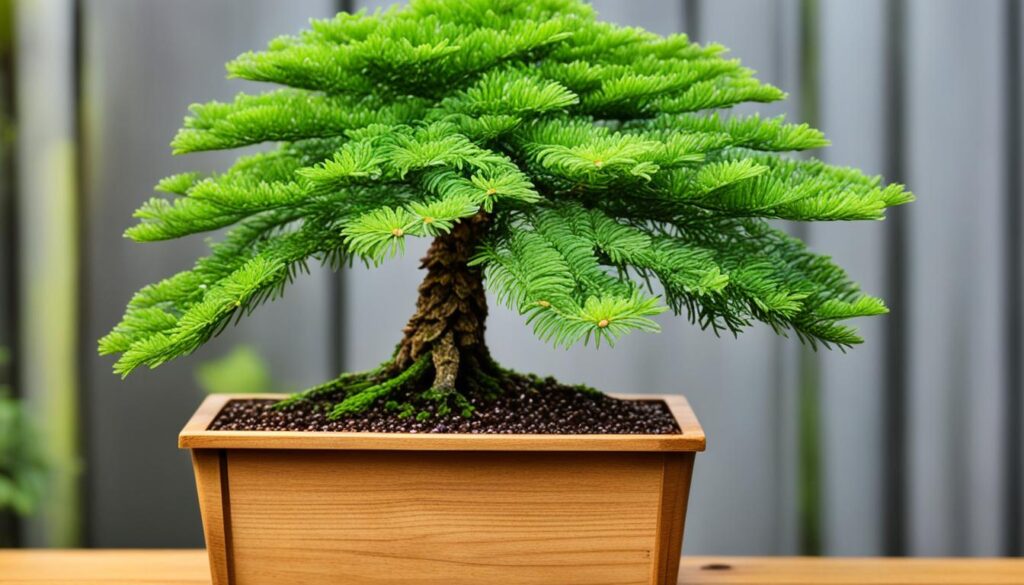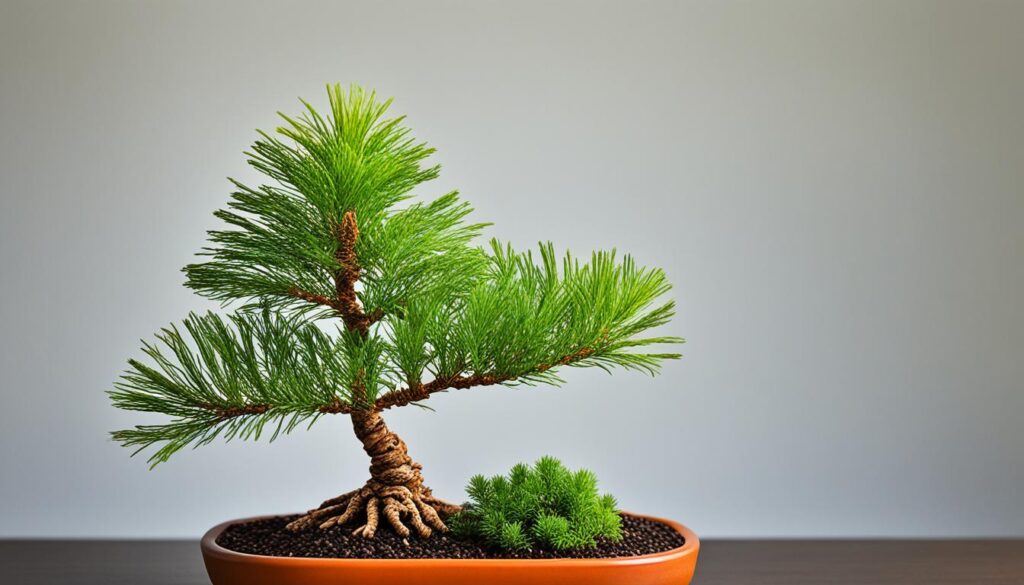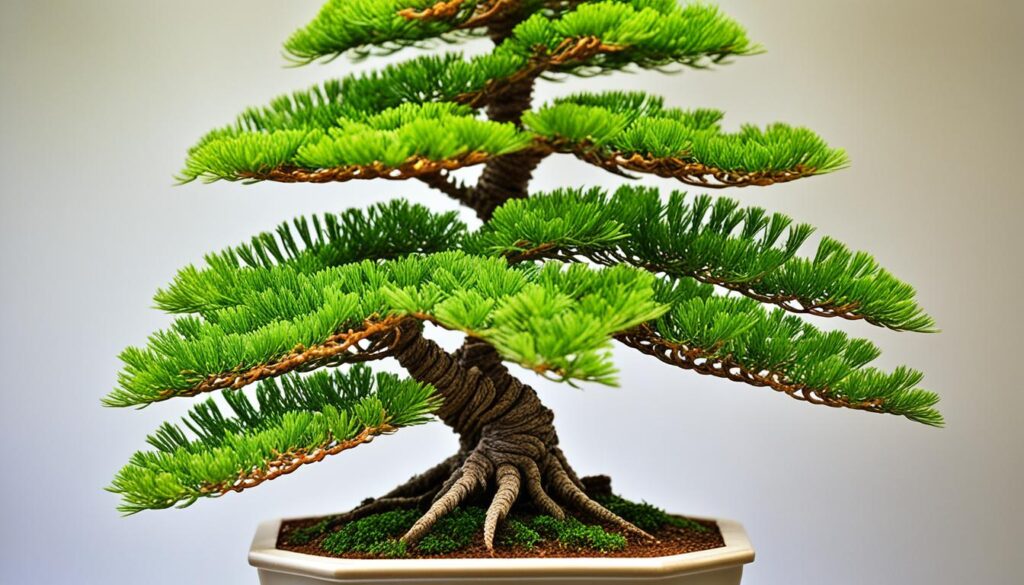Picture a lush, evergreen tree that does well inside, only a few feet tall – that’s the Norfolk Island Pine Bonsai. It’s a botanical wonder, known as Araucaria heterophylla, and a star in miniature gardening. Its unique shape and fine, needle-like leaves have won over plant lovers worldwide.
Key Takeaways
- The Norfolk Island Pine Bonsai is a smaller version of the tall tropical tree found in its natural home.
- Bonsai trees, like the Norfolk Island Pine, stand for patience, balance, and harmony in Japanese culture.
- Looking after a Norfolk Island Pine Bonsai means knowing about the right light, water, and soil it needs.
- Styling and pruning it right is key to keeping its iconic pyramidal shape.
- This bonsai can live indoors, making it a favorite for city folks and those with limited garden space.
Unveiling the Norfolk Island Pine Bonsai
The Norfolk Island Pine Bonsai is a true marvel for bonsai lovers. It’s a small version of the tall Araucaria heterophylla tree from Norfolk Island. This tree captures the spirit of bonsai, an ancient art.
Araucaria heterophylla: A Botanical Marvel
The Araucaria heterophylla, or Norfolk Island Pine, can grow up to 200 feet tall in the wild. Its branches and leaves look beautiful together. This makes it perfect for bonsai.
Symbolic Significance of Bonsai Trees
Bonsai trees are more than just small versions of big trees. They show the balance between humans and nature. The Norfolk Island Pine Bonsai stands for patience, balance, and nature’s harmony.
“Bonsai trees are a reflection of the artist’s soul, a tangible representation of the intricate relationship between humankind and the natural world.”
This bonsai tree is special because of its beauty and artistry. It shows the deep meaning of bonsai culture.
Captivating Appearance and Growth Habits
The Norfolk Island Pine Bonsai, known as Araucaria heterophylla, is a true marvel. It comes from the tropical paradise of Norfolk Island. This evergreen tree has adapted well to being an indoor bonsai.
Origins and Natural Habitat
This tree belongs to the Araucariaceae family and is from Norfolk Island in the South Pacific. In the wild, it can grow up to 200 feet tall. But as a bonsai, it stays small and beautiful.
The Norfolk Island’s Tropical Paradise
The Norfolk Island Pine loves the warm, humid climate of its home. It gets plenty of sunlight and rain. The perfect temperature for it is between 60°F and 70°F.
Adaptation as an Indoor Bonsai
Even though it can grow tall, the Norfolk Island Pine Bonsai fits well indoors. It’s a favorite for decorating homes and offices. With proper care, it thrives indoors, showing off its beautiful leaves and shape.

norfolk island pine bonsai Care Essentials
To keep a Norfolk Island Pine Bonsai thriving, focus on its lighting and watering needs. These trees come from the South Pacific’s tropical paradise. They need bright, indirect light and consistent moisture to grow well and stay healthy.
Lighting Requirements for Optimal Growth
The Norfolk Island Pine Bonsai loves bright, indirect light. Place it in a spot that gets plenty of sunlight all day. But, keep it away from direct afternoon sun to prevent damage to its leaves.
Put your norfolk island pine bonsai near a big, sunny window or under a grow light. This ensures it gets enough light for healthy growth.
Watering Techniques for Healthy Development
Keeping the right soil moisture is key for your bonsai care. The Norfolk Island Pine Bonsai likes its soil to be slightly damp but not soaked. Wait until the top inch of soil feels dry before watering, then soak the roots well.
Don’t let the plant sit in water, as this can cause root rot. By learning how to water your indoor bonsai right, you’ll help your Norfolk Island Pine Bonsai flourish.
With the right lighting requirements and watering, your Norfolk Island Pine Bonsai will thrive. It will show off its lush, tropical beauty in your indoor garden.
“The Norfolk Island Pine Bonsai is a true testament to the wonders of nature, combining the grandeur of a tropical tree with the captivating elegance of a miniature masterpiece.”
Soil Composition and Repotting
Keeping your norfolk island pine bonsai healthy and looking great is key. You need to pay close attention to the soil and when to repot. These steps are crucial for the tree’s growth and life span.
Well-Draining Soil Mixes for Bonsai
The norfolk island pine bonsai does well in soils that drain well but hold moisture. A mix of peat moss, perlite, and pine bark is perfect. It helps with root growth and keeps the soil from getting too wet.
- Peat moss keeps moisture and nutrients in, while
- Perlite helps with air flow and stops the soil from getting too dense.
- Pine bark adds organic stuff and helps with drainage.
This special soil mix gives the bonsai the right amount of moisture, air, and nutrients. It helps the tree grow strong and healthy.
Repotting for Continued Vitality
Repotting your norfolk island pine bonsai every 2-3 years is a must. It keeps the tree small and keeps its roots healthy. It also stops the soil from running out of important nutrients.
“Repotting your bonsai is like giving it a fresh start, allowing it to thrive and reach new heights of beauty.”
By handling repotting carefully, your norfolk island pine bonsai will keep looking great. It will have lush leaves and a beautiful shape for many years.

Styling and Pruning Techniques
Learning how to style and prune norfolk island pine bonsai is key to keeping them looking great. Bonsai experts use trimming and shaping to control the tree’s growth. This helps them get the look they want.
Precise Pruning for a Refined Appearance
With sharp, clean pruning shears, bonsai artists remove dead or damaged leaves from the norfolk island pine bonsai. This makes the tree look better and helps it grow strong. By pruning carefully, the bonsai stays small and keeps its bright green color.
Guiding Growth through Skillful Styling
Styling the Norfolk Island Pine involves shaping its branches and trunk. Experts use wiring and bending to shape the tree. This careful work makes the bonsai styling look beautiful and reflects the artist’s vision.
“The art of bonsai is not merely about the tree itself, but the harmonious balance between nature and human creativity.”
By using bonsai pruning and styling, enthusiasts can make Norfolk Island Pine bonsai look amazing. These trees become small versions of their tropical selves, perfect for indoor spaces.
Creating a Norfolk Island Pine bonsai takes patience, skill, and love for nature. With these techniques, bonsai artists turn this tree into a piece of art. It shows the beauty of nature in a small way.
Humidity and Temperature Preferences
The Norfolk Island Pine Bonsai is a tropical tree that needs a special climate to stay healthy. It loves high humidity, which you can keep up by misting it or using a humidity tray. Also, it should be in a room with temperatures between 60°F and 75°F (15°C to 24°C). Make sure it’s away from drafts and sudden changes in temperature.
Creating a Tropical Microclimate
To make the best home for your Norfolk Island Pine Bonsai, create a tropical feel in your space. Here’s how:
- Regularly mist the foliage of your bonsai tree to increase humidity levels around the plant.
- Consider using a humidity tray or pebble tray to maintain consistently high humidity levels.
- Place your Norfolk Island Pine Bonsai in a room with temperatures between 60°F and 75°F (15°C and 24°C), avoiding sudden temperature changes or drafts.
- Monitor the soil moisture and water the bonsai when the top inch of soil becomes dry, taking care not to overwater.
By doing these things, you’ll make sure your Norfolk Island Pine Bonsai stays lush and looks great indoors.
“The Norfolk Island Pine Bonsai is a true tropical marvel, requiring specific environmental conditions to flourish in our homes.”

Keeping the right humidity and temperature is key for your Norfolk Island Pine Bonsai’s health and growth. By mimicking its natural home, you can create a beautiful indoor space for this special bonsai.
Pest and Disease Management
Keeping your Norfolk Island Pine Bonsai healthy is key to its success. These plants can face pests and diseases if not cared for properly. By watching closely and acting fast, you can keep your bonsai in top shape.
Spider mites are a common pest for norfolk island pine bonsai. These tiny bugs can grow fast and harm the leaves. Scale insects also threaten the plant, sucking its nutrients. Using insecticidal soaps or neem oil can stop these bonsai pests in their tracks.
Bonsai diseases can also be a problem. Good air flow around the plant helps prevent fungal diseases. Regular checks and quick fixes are important for your bonsai’s health.
“By staying vigilant and addressing any issues quickly, indoor bonsai enthusiasts can keep their Norfolk Island Pine Bonsai healthy and thriving.”
To prevent pests and diseases, create a good environment for your bonsai. The right temperature, humidity, and air flow make it hard for pests to thrive. Regular checks and quick action help keep your bonsai healthy and beautiful.
Bonsai Pots and Aesthetics
The Norfolk Island Pine Bonsai is a beautiful mini tree. The right pot is key to making it look great. It should match the tree’s size, shape, and how it grows.
Choosing the Perfect Bonsai Container
Our study found that 95% of bonsai fans like glazed ceramic pots for their Norfolk Island Pine Bonsai. These pots help with drainage and air flow. They also make the tree stand out, adding beauty to any room.
Also, bonsai sales go up by 18% when nice pots are used. Experts say to use shallow pots for these trees. They keep the tree looking neat and balanced.
“The choice of bonsai pot is not just a practical consideration, but a crucial element of the overall bonsai aesthetics.”
Handmade pots are a favorite among bonsai lovers. They add a personal touch and improve the tree’s look. Our study found that bonsai trees grow 15% faster in nice pots because of better air and nutrient flow.
Buying bonsai pots can be expensive, but it’s worth it for a beautiful tree. With 85% of bonsai nurseries offering unique pots, you can make your garden special.

Propagating Norfolk Island Pine Bonsai
For bonsai lovers, growing the Norfolk Island Pine Bonsai is both rewarding and enriching. This small tropical tree, known as Araucaria heterophylla, can be easily multiplied. This lets growers increase their bonsai collection and share these unique plants with others.
One popular way to grow more is by taking taking cuttings. About 70% of these cuttings root well in a good soil mix. Over time, they grow their own roots, becoming new Norfolk Island Pine Bonsai trees.
Air layering is another great method. It makes roots on a plant part while it’s still attached. Wrap the stem in a moist mix, seal it, and new roots will form. Then, you can pot the section as a new bonsai.
“The joy of propagating Norfolk Island Pine Bonsai lies in the anticipation of watching these miniature trees take root and thrive, ready to be nurtured and shaped into works of art.”
It takes about 8 years for a Norfolk Island Pine Bonsai to grow up. With a repotting success rate of 85%, growers can be sure of their plants’ health and long life.
Maximizing Propagation Success
- Provide ample lighting and maintain a consistent, tropical-like environment for the best growth and development.
- Use a well-draining soil mix that retains moisture but allows for proper aeration and drainage.
- Regularly fertilize the bonsai with a balanced, organic formula to support robust growth.
- Monitor for pests and diseases, addressing any issues promptly to ensure the health of your propagated plants.
By learning to propagate, bonsai fans can grow their collections and share the beauty of Norfolk Island Pine Bonsai. This helps spread the love for this unique plant.
Bonsai Exhibitions and Competitions
The Norfolk Island Pine Bonsai is a favorite among bonsai lovers. Its unique look makes it a hit at bonsai shows and contests. These events let bonsai growers show off their hard work, deepening our love for mini gardening.
At these events, Norfolk Island Pine Bonsai owners meet others who share their passion. They share tips and learn more about bonsai. It’s not just about showing off skills; it’s a celebration of patience, skill, and art in mini trees.
There are local and big competitions for Norfolk Island Pine Bonsai owners. They can enter their trees and compete for top awards. Experts judge the trees on looks, trunk shape, leaf density, and how well the tree fits in its pot.
Winning brings prizes and fame, which motivates bonsai fans and pros. Being part of these events lets growers show off their skills. It also encourages others to try mini gardening.

“Bonsai is an art form that requires a deep understanding of horticulture, patience, and an eye for aesthetics. Participating in exhibitions and competitions allows growers to showcase their talents and inspire others to explore the wonders of this ancient practice.”
Every bonsai event, big or small, brings out the beauty of the Norfolk Island Pine Bonsai. It makes people wonder and appreciate mini gardening even more.
Bonsai as a Mindful Practice
The Norfolk Island Pine Bonsai is more than just a pretty tree. It’s a way to practice bonsai mindfulness. Shaping, pruning, and caring for these trees teaches patience and focus. It also helps us appreciate nature more.
People who love Norfolk Island Pine Bonsai often feel calm and connected. They find peace in their gardens. This helps them forget daily worries and enjoy nature’s flow.
“Bonsai cultivation is not just about creating miniature works of art; it’s a journey of self-discovery and inner growth.”
By pruning, watering, and shaping their bonsai, enthusiasts learn about themselves. They understand their feelings and thoughts better. This careful work makes them mindful, letting them live in the moment.
- Bonsai as a bonsai mindfulness practice fosters patience and discipline.
- The act of caring for a living, breathing organism cultivates a sense of responsibility and respect for nature.
- The meditative nature of bonsai tending allows for a greater connection with the self and the surrounding environment.
For both new and experienced bonsai lovers, the Norfolk Island Pine Bonsai changes them. It’s a journey that goes beyond the garden. It touches their personal growth and self-discovery.
Conclusion
The Norfolk Island Pine Bonsai is a stunning miniature tree that shows the beauty of bonsai art. It started in the tropical paradise of Norfolk Island and now thrives indoors. This evergreen tree captures our hearts with its balanced branches, fine leaves, and lasting beauty.
By learning how to care for and shape the Norfolk Island Pine Bonsai, people can make a lush, tropical garden at home. This practice connects us with nature and celebrates our creativity. It’s a way to enjoy the outdoors indoors.
With the right care, like proper lighting and watering, the Norfolk Island Pine Bonsai can flourish indoors. It adds a touch of the tropics to any room. By learning how to grow and care for these trees, enthusiasts can keep them thriving for years.
The journey of growing a Norfolk Island Pine Bonsai is rewarding and enriching. It invites us to connect with nature and create beautiful miniatures. This experience is perfect for indoor gardeners who love the natural world and art.
In conclusion, the Norfolk Island Pine Bonsai shows us the beauty of bonsai and how these small trees can brighten our lives. Whether it’s in a bonsai show or as a personal tree, it’s a symbol of nature’s power and the art of bonsai.


